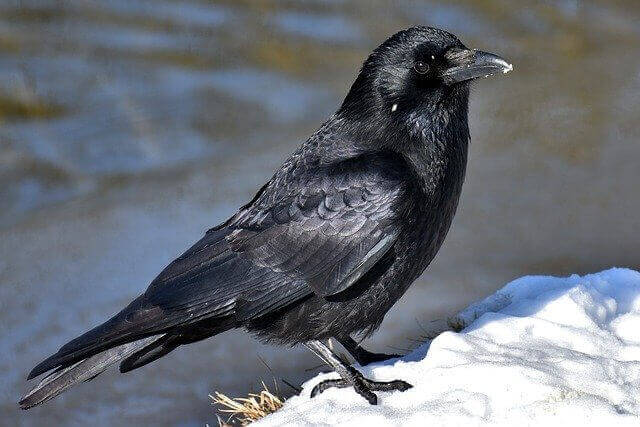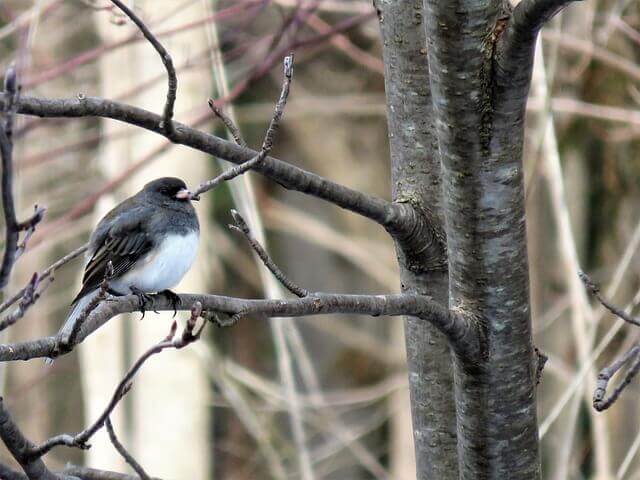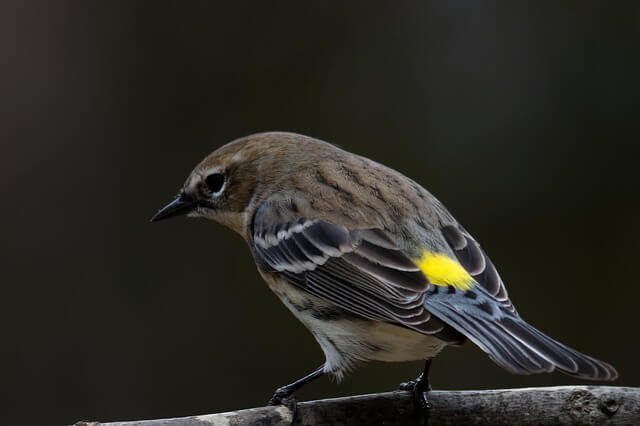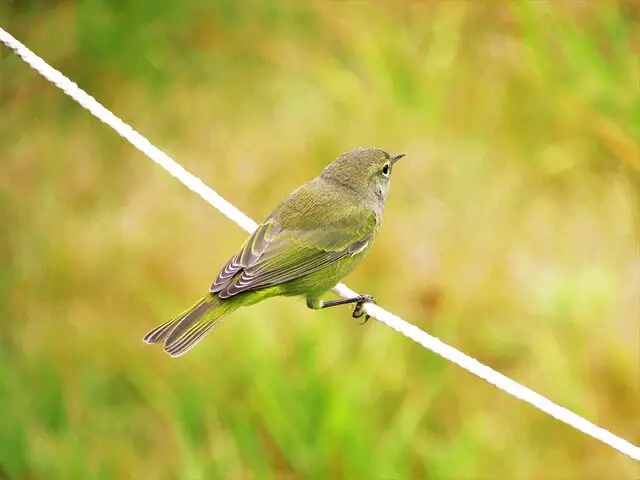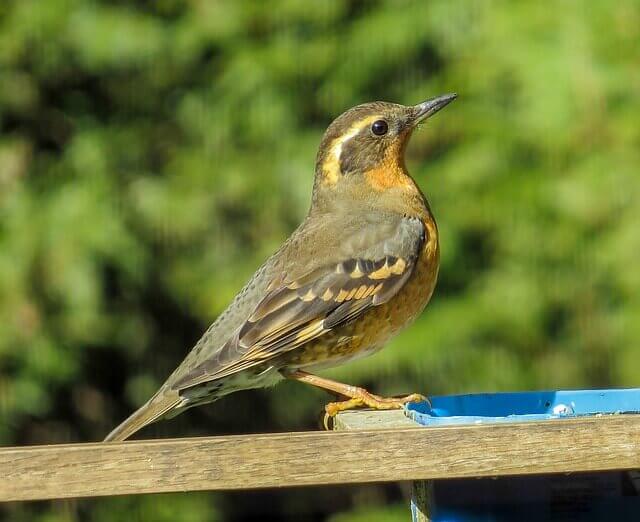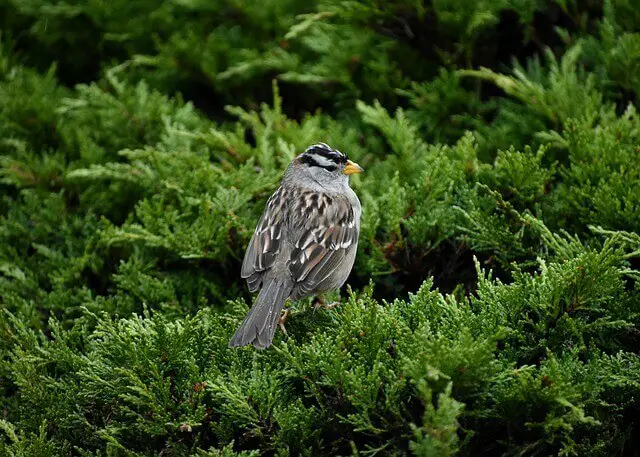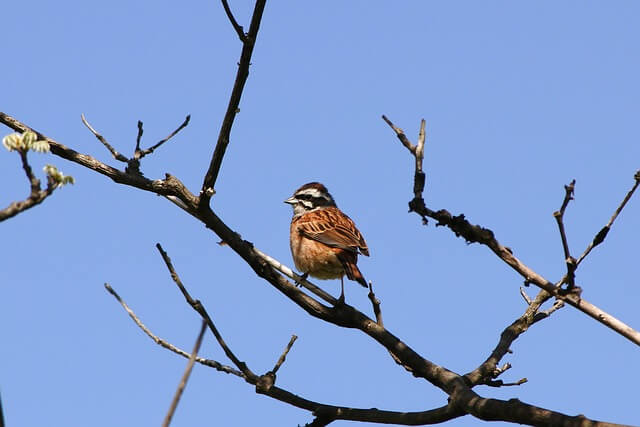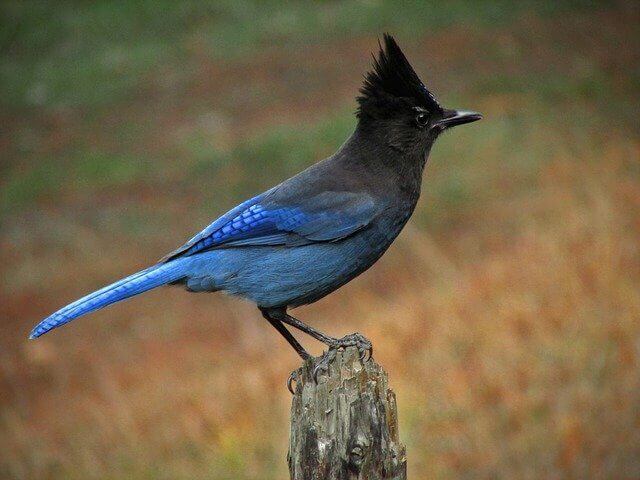Embark on an Alaskan birdwatching adventure! From icy tundras to rugged coastlines, Alaska is home to a unique blend of bird species. In this guide, we’ll introduce you to the 35 most common birds you’re likely to encounter across the Last Frontier. Whether you’re a seasoned birder or a curious explorer, this guide will enhance your birdwatching experiences in Alaska.
Table of Contents
- 1 Most Common Birds in Alaska
- 1.1 Common Raven
- 1.2 American Robin
- 1.3 Dark-eyed Junco
- 1.4 Black-billed Magpie
- 1.5 Black-capped Chickadee
- 1.6 Common Redpoll
- 1.7 Northwestern Crow
- 1.8 Yellow-rumped Warbler
- 1.9 Savannah Sparrow
- 1.10 Orange-crowned Warbler
- 1.11 Varied Thrush
- 1.12 White-crowned Sparrow
- 1.13 Song Sparrow
- 1.14 Ruby-crowned Kinglet
- 1.15 Lapland Longspur
- 1.16 Pine Siskin
- 1.17 Red-breasted Nuthatch
- 1.18 Fox Sparrow
- 1.19 Steller’s Jay
- 2 Frequently Asked Questions
- 2.1 What are the black and white birds called in Alaska?
- 2.2 What are the big black birds in Alaska?
- 2.3 What is the most common bird in Alaska?
- 2.4 What is the national bird of Alaska?
- 2.5 What is the black bird in Alaska?
- 2.6 Does Alaska have ravens or crows?
- 2.7 Are there blue jays in Alaska?
- 2.8 What bird has a yellow feather in Alaska?
- 2.9 Does Alaska have finches?
- 2.10 Are there puffins in Alaska?
- 2.11 Does Alaska have cardinals?
- 2.12 Does Alaska have pigeons?
- 2.13 Does Alaska have pheasants?
- 2.14 Does Alaska have a lot of birds?
- 2.15 What kind of grouse are in Alaska?
- 2.16 Are chickadees in Alaska?
- 2.17 Are juncos in Alaska?
- 2.18 Are toucans in Alaska?
- 2.19 Are there meadowlarks in Alaska?
- 2.20 Do mockingbirds live in Alaska?
- 2.21 Are there doves in Alaska?
- 3 Author
Most Common Birds in Alaska
Common Raven
The Common Raven is a large, black bird that is found across North America. Ravens are known for their intelligence and problem-solving ability. Ravens are also one of the few bird species that can mimic human speech.
Ravens typically live in forests, but they can also be found in mountains, deserts, and tundra. Ravens are opportunistic eaters and will eat just about anything they can find. This includes insects, small mammals, carrion, and garbage.
- Frequency: 35.26% (Statistic: eBird)
- Color: Has a black, iridescent plumage.
- Habitat: Wooded areas, evergreen forests, tundra, roadside, grasslands, backyards, parks.
- Range: Found throughout the Northern Hemisphere.
- Size: 21 – 26 inches long
- Weight: 1.5 – 4.5 lbs.
- Diet: Mainly scavengers, feeding on carrion, beetles, and maggots.
- Family: Corvidae
- Genus: Corvus
- Maps: Range Map – Sightings Map
- Sounds: Calls and Songs
Related: 18 Fun Facts About Ravens That Will Amaze You
American Robin
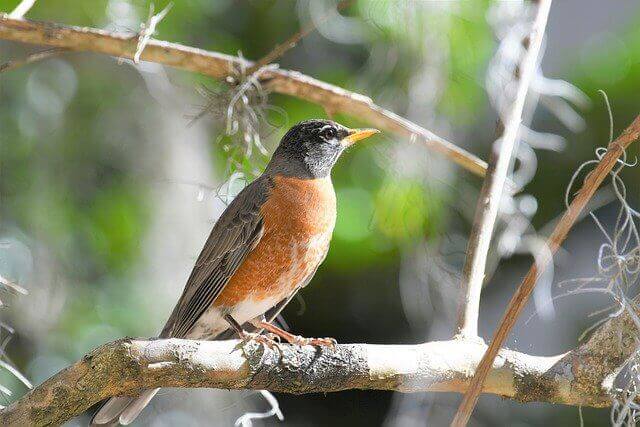
The American Robin is a migratory songbird that ranges throughout North America. Robins are common in urban and suburban areas, and their cheerful songs are a welcome sign of spring. These birds are adaptable and can be found in a variety of habitats, from forests to fields.
Robins predominantly feed on insects, but they will also eat fruits, and berries. In winter, when insects are scarce, robins often visit backyard bird feeders. By providing food and shelter, we can help these delightful birds survive the cold months.
- Frequency: 23.31%
- Color: Mostly brown on the back with an orange colored breast.
- Habitat: Wooded areas, backyards, parks, fields.
- Range: USA, Canada, Mexico
- Size: 12 – 16″ inches
- Weight: 72 – 95 grams
- Diet: Fruits, berries and insects (earthworms, beetles, caterpillars)
- Family: Turdidae
- Genus: Turdus
- Maps: Range Map – Sightings Map
- Sounds: Calls and Songs
Related: Interesting American Robin Fun Facts
Dark-eyed Junco
The Dark-eyed Junco (Junco hyemalis) is a small sparrow that is common across North America. These birds are easily recognized by their slate-gray upperparts and white underparts, with a black hood and white throat. Their breeding range extends from Alaska and Canada to the southern United States, and they can be found in a variety of habitats, including forests, mountains, and gardens. These birds are mostly granivorous, feeding on seeds and berries.
However, they will also eat insects, especially during the breeding season when they are feeding their young. In winter, when food is scarce, they may visit bird feeders. The dark-eyed junco is not currently considered to be at risk of extinction. However, like many other bird species, they are facing threats from habitat loss and degradation.
- Frequency: 23.12%
- Color: Gray head, neck, breast, gray/brown backs and wings, white underside.
- Habitat: Wooded areas, forest edges, roadsides, gardens, parks.
- Range: USA and Canada
- Size: 5.1 – 6.9″ inches
- Weight: 18 – 30 grams
- Diet: Seeds, insects, and arthropods
- Family: Passeriformes
- Genus: Junco
- Maps: Range Map – Sightings Map
- Sounds: Calls and Songs
Related: Fun Facts About Dark-eyed Juncos
Black-billed Magpie
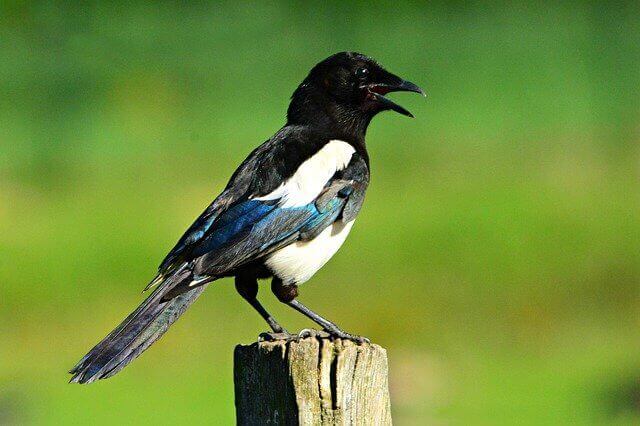
The black-billed magpie is a crow family member. It is about the same size as a blue jay and has black, blue and white plumage. The black-billed magpie ranges from Alaska and Canada to Mexico. In the United States, it is found in the western states, including Montana, Wyoming, Colorado, New Mexico, Arizona, Utah, Nevada, California, Oregon, and Idaho.
It prefers open habitats such as forests, woodlands, grasslands, and scrublands. The diet of the black-billed magpie consists mostly of insects and other invertebrates. It will also eat small mammals, birds, eggs, reptiles, amphibians, nuts, berries, and fruits.
- Frequency: 19.21%
- Color: Dense plumage, shorter and rounder wings, longer tail, and has blue iridescent feathers.
- Habitat: Trees, open areas, parks and fields.
- Range: USA and Canada
- Size: 18″ – 24″ inches
- Weight: 167 – 216 grams
- Diet: All types of insects, seeds, carrion, berries, rodents, nuts, eggs, and garbage.
- Family: Passeriformes
- Genus: Corvidae
- Maps: Range Map – Sightings Map
- Sounds: Calls and Songs
Related: How to Attract Magpies to your Garden? (In 4 Easy Steps!)
Black-capped Chickadee
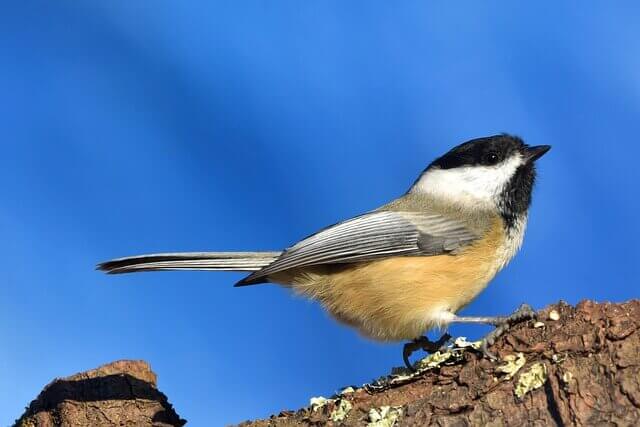
Black-capped chickadees are small, sprightly songbirds with black caps and chests and gray backs and wings. Found throughout North America, these birds thrive in both forests and urban areas. Chickadees are especially fond of sunflower seeds, but their diet also includes insects, berries, and other small fruits. These adaptable birds can be found in a variety of habitats including woodlands, parks, and gardens.
Black-capped chickadees are especially common in deciduous forests, where they nest in tree cavities. They will also readily use man-made nesting boxes. Chickadees are nonmigratory birds, but some populations move to lower elevations in winter. In general, though, these little birds stay close to home year-round.
- Frequency: 18.17%
- Color: Black-cap, white on face, white/reddish-brown flanks
- Habitat: Deciduous and mixed forests, backyards, parks
- Range: USA and Canada
- Size: 11.5 -16 cm length
- Weight: 8 – 15 grams
- Diet: Insects, seeds, berries
- Family: Paridae
- Genus: Poecile
- Maps: Range Map – Sightings Map
- Sounds: Calls and Songs
Related: How Do I Attract Chickadees To My Yard?
Common Redpoll
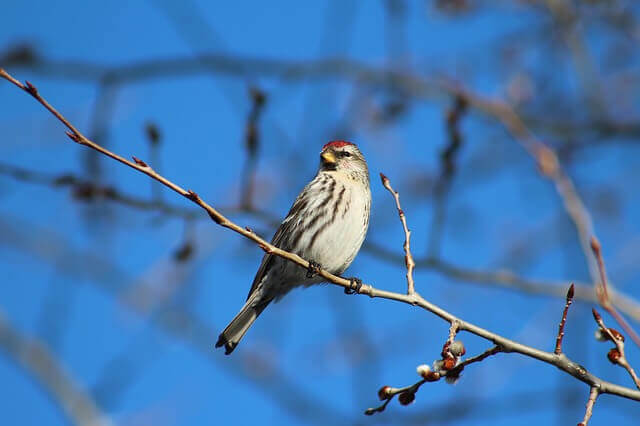
The Common Redpoll is a small, sparrow-like finch with a reddish breast and crown. The wings are pale with dark streaks, and the tail is black with white edges. The bill is short and stubby, and the legs are pink. Males and females look alike, although males may have a more brightly colored breast.
Common Redpolls breed in open tundra and taiga habitats across Northern Europe and Asia. In winter, they move south to woodlands, fields, and marshes where they feed on seeds, buds, berries, and insects. They often form large flocks with other finches, such as Pine Siskins and Common Crossbills.
- Frequency: 14.52%
- Color: Small brownish-gray with dark streaks and a bright red patch on its forehead.
- Habitat: Deciduous and mixed forests, backyards, parks.
- Range: USA and Canada
- Size: 4.5″ – 5.5″ length
- Weight: 12 – 16 grams
- Diet: birch seeds
- Family: Fringillidae
- Genus: Acanthis
- Maps: Range Map – Sightings Map
- Sounds: Calls and Songs
Northwestern Crow

The Northwestern Crow is a species of crow that is found in northwestern North America. The range of the Northwestern Crow extends from southeastern Alaska to central California. The habitat of the Northwestern Crow includes forests, coastal areas, and urban areas. The diet of the Northwestern Crow consists of insects, small mammals, fruits, and seeds. The Northwestern Crow is a dark-colored bird with a wingspan of about 3 feet.
The body length of the Northwestern Crow is about 16 inches. The male and female Northwestern Crows are similar in appearance. The nesting season of the Northwestern Crow begins in April and ends in August. The nests of the Northwestern Crow are usually built in trees or on cliffs. The clutch size of the Northwestern Crow is usually 4 to 6 eggs.
- Frequency: 13.75%
- Color: Black
- Habitat: Bays or rivers, beaches, islands, and landfills
- Range: coastal regions and offshore islands of southern Alaska, and from Washington to British Columbia
- Size: 16.5″ – 17.5″″ inches
- Weight: 3385 – 450 grams
- Diet: Invertebrates, small vertebrates, eggs, nestlings, carrion, fruit, seeds, and garbage
- Family: Corvidae
- Genus: Corvis
- Maps: Range Map – Sightings Map
- Sounds: Calls and Songs
Yellow-rumped Warbler
The Yellow-rumped Warbler is a small North American songbird. Its breeding range extends from Alaska and Canada to the southern United States. This warbler is a habitat generalist and can be found in a variety of habitats, including forests, wetlands, and gardens. The Yellow-rumped Warbler has a broad diet that includes insects, berries, and nectar. This warbler is one of the most abundant and widespread songbirds in North America.
- Frequency: 12.91%
- Color: Yellow with reddish streaks on the underparts
- Habitat: Pastures, thickets, brushy areas, prairies, grasslands, parks and fields,
- Range: USA and Canada
- Size: 4.0″ – 7.1″ inches long
- Weight: 7 – 25 grams
- Diet: Mayflies, moths, mosquitoes, beetles, damselflies, treehoppers, spiders, and berries.
- Family: Parulidae
- Genus: Setophaga
- Maps: Range Map – Sightings Map
- Sounds: Calls and Songs
Related: How to Attract Warblers to your Yard? (Expert Tips)
Savannah Sparrow
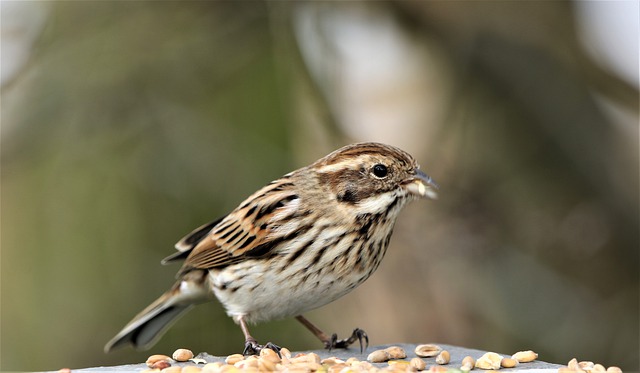
The Savannah Sparrow is a small songbird that breeds in open habitats across North America. It is named after the city of Savannah, Georgia, where it was first described by 19th century ornithologist Alexander Wilson. The bird is grayish-brown above and pale below, with a streaked breast and a long, pointed bill.
Its breeding habitat is grassy areas with little or no trees, including meadows, fields, and marshes. The Savannah Sparrow typically nests on the ground, sometimes using man-made structures such as fences or road signs. The bird’s diet consists mostly of insects and other invertebrates, although it will also eat seeds and berries.
- Frequency: 12.54%
- Color: White crown, white throat, streaked brown back, whitish underparts with brown or blackish breast and flank streaking
- Habitat: Grassy coastal dunes, farmland, sub-alpine meadows
- Range: Canada, Alaska, northern, central and Pacific coastal United States, Guatemala and Mexico
- Size: 4.3″ – 6.7″ inches
- Weight: 15 – 29 grams
- Diet: Grains, seeds, and insects
- Family: Passerellidae
- Genus: Passerculus
- Maps: Range Map – Sightings Map
- Sounds: Calls and Songs
Orange-crowned Warbler
The Orange-crowned Warbler is a small songbird that ranges across much of North America. Orange-crowned Warblers are small songbirds with olive-green upperparts and yellowish underparts. They have a distinctive orange patch on their crown, which is usually only visible when they are singing. These warblers breed across much of North America, from Alaska and Canada down to Mexico.
In winter, they can be found as far south as Central America. These warblers are most often found in woodlands, but can also be seen in scrubby areas and even urban parks. Diet consists mostly of insects, but they will also eat berries and other fruits.
- Frequency: 12.46%
- Color: Olive-gray upper parts, yellowish underparts with light streaking and a thin pointed bill
- Habitat: woods and thickets along edges of streams, lakes, marshes, and swamps
- Range: Coastal Alaska, Northern Rockies
- Size: 4.3″ – 5.5″ inches
- Weight: 7 – 11 grams
- Diet: invertebrate prey, including ants, beetles, spiders, flies, and caterpillars
- Family: Parulidae
- Genus: Leiothlypis
- Maps: Range Map – Sightings Map
- Sounds: Calls and Songs
Varied Thrush
The Varied Thrush is part of the Thrush family. It is a medium-sized bird with dark rusty brown upperparts, pale rust-colored underparts, and a white throat. The bill is black, and the legs are pink. The adult male has a black head with white streaks. Females and juveniles lack the black head markings.
This bird can be found in forests of the Pacific Northwest, from southern Alaska to northern California. It prefers coniferous or mixed forests with dense understory vegetation. The diet of the Varied Thrush consists mostly of insects and berries. In winter, it will eat more fruits and nuts.
- Frequency: 11.74%
- Color: Orange and black feathers, has an orange, and gray pattern at the breasts and throat
- Habitat: Orchards, conifer forests and thickets
- Range: Western North America from Alaska to northern California
- Size: 7.9″ -10.2″ inches
- Weight: 65 – 100 grams
- Diet: Fruits and berries
- Family: Turdidae
- Genus: Ixoreus
- Maps: Range Map – Sightings Map
- Sounds: Calls and Songs
Related: How to Attract Thrushes to your Garden? (Expert Tips!)
White-crowned Sparrow
The White-crowned Sparrow is a sparrow native to North America. It breeds in northern Canada and the western United States and winters in the southern United States, Mexico, and Central America. The White-crowned Sparrow is a medium-sized sparrow with a gray back, white underparts, and a black-and-white striped head. The male has a black crown with white stripes; the female has a brown crown with tan stripes.
The bird’s diet consists of seeds, insects, and berries. The White-crowned Sparrow is found in open habitats such as fields, meadows, and gardens. It nests on the ground in grassy areas or in trees. The White-crowned Sparrow is one of the most common birds in North America. It is not considered threatened or endangered.
- Frequency: 11.67%
- Color: Gray face, and black and white streaking on the upper head
- Habitat: Brushy areas in the tundra and taiga
- Range: Pacific coast and Rocky Mountains
- Size: 5.9 – 6.3″ inches
- Weight: 25 – 28 grams
- Diet: Plant parts, seeds, and insects
- Family: Passerellidae
- Genus: Zonotrichia
- Maps: Range Map – Sightings Map
- Sounds: Calls and Songs
Song Sparrow
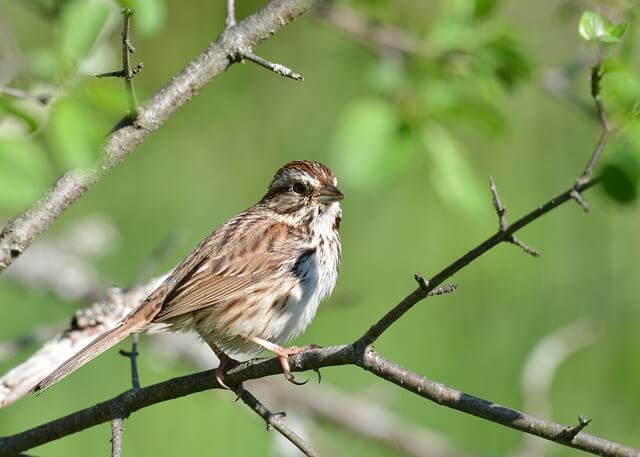
The song sparrow (Melospiza melodia) is a small bird that can be found in a variety of habitats across North America. The song sparrow is a relatively small bird, with a body length of between 4 and 6 inches. The song sparrow has a brown back and wings, with lighter colored underparts. The Song Sparrow is one of the most widespread birds in North America, with a range that extends from Alaska to Newfoundland, and south to California and Florida.
The song sparrow can be found in a variety of habitats, including forests, grasslands, and wetlands. The song sparrow is an important part of the ecosystem, as it provides food for many predators. The diet of the song sparrow consists mainly of insects and seeds.
- Frequency: 10.92%
- Color: Gray head, white cheek, a black bib, rufous neck.
- Habitat: Urban centers, farms, backyards, edges, yards, and parks.
- Range: Europe, Mediterranean, Asia, Australasia, Africa, and the Americas.
- Size: 5.5 – 7.0″ inches
- Weight: 25 – 40 grams
- Diet: Grains, seeds, and insects
- Family: Passerellidae
- Genus: Passer
- Maps: Range Map – Sightings Map
- Sounds: Calls and Songs
Related: How to Attract Sparrows to your Backyard? (Like A Pro)
Ruby-crowned Kinglet
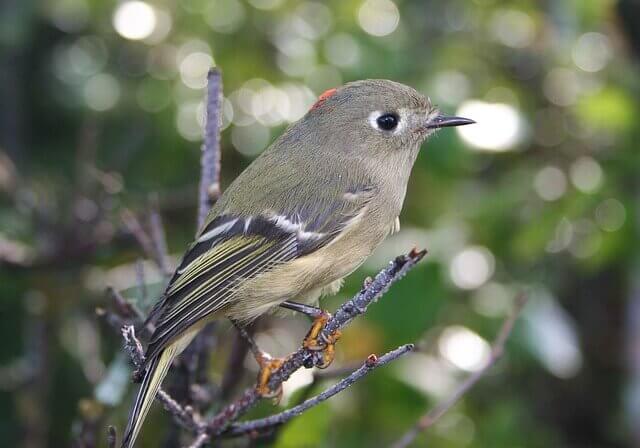
The Ruby-crowned Kinglet is a songbird that is native to many parts of North America. These birds are constantly in motion and can be difficult to spot, but their loud, distinctive calls make them easy to identify. The male Ruby-crowned Kinglet has a bright red crown, which is usually only visible when he is singing. These birds breed in the boreal forests of Canada and the northern United States. In the winter, they migrate south to escape the cold weather.
They can be found in woodlands, scrubland, and even urban areas during this time. The Ruby-crowned Kinglet’s diet consists mostly of insects. They will also eat spiders, berries, and other small fruits. These birds are important members of the ecosystem because they help control insect populations.
- Frequency: 10.70%
- Color: Gray head, white cheek, a black bib, rufous neck
- Habitat: Spruce-fir forests in the north, and mountainous regions
- Range: Northwest Canada and Alaska, and south to Mexico
- Size: 3.5″ – 4.3″ inches
- Weight: 5 – 10 grams
- Diet: Insectivorous, seeds and fruit
- Family: Regulidae
- Genus: Regulus
- Maps: Range Map – Sightings Map
- Sounds: Calls and Songs
Lapland Longspur
The Lapland Longspur is a small songbird that breeds in the Arctic tundra of North America and Eurasia. The bird is named for its long tail, which is often held upright when the bird is in flight. The Lapland Longspur is about 15 cm (6 inches) long and has a black bill, black legs, and brownish-black wings with white stripes. The bird’s breeding habitat is the open tundra, where it nests on the ground.
The Lapland Longspur winters in southern Canada and the northern United States. The Lapland Longspur feeds on insects and seeds. In summer, the bird eats mostly insects, such as beetles and grasshoppers. In winter, the diet shifts to include more seeds from plants such as sedges and rushes.
- Frequency: 9.97%
- Color: Black head and throat, white eyestripe, chestnut nape, white underparts, and a black-gray back.
- Habitat: Spruce-fir forests in the north, and mountainous regions.
- Range: Arctic Europe, and the Palearctic, Northernmost United States, and in Canada.
- Size: 5.9″ – 6.3″″ inches
- Weight: 22 – 33 grams
- Diet: Seeds, arthropods
- Family: Calcariidae
- Genus: Calcarius
- Maps: Range Map – Sightings Map
- Sounds: Calls and Songs
Pine Siskin
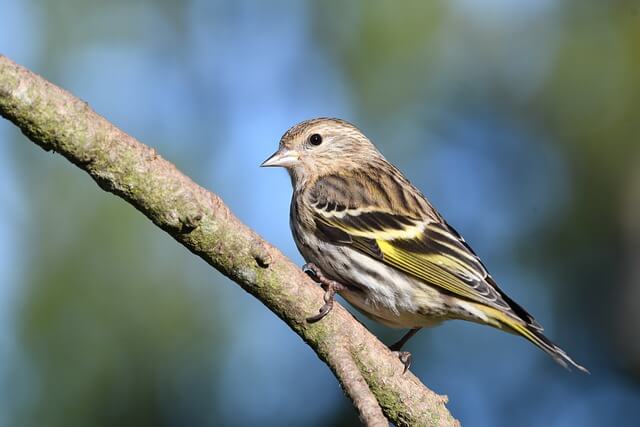
Pine Siskins are small, brownish-gray birds with streaks of gold on their wings and tails. They are found in coniferous forests across North America and parts of Europe. Pine siskins eat mostly seeds, but will also eat insects. Pine siskins are small birds, measuring only 4 to 5.5 inches in length. They have brownish-gray feathers with streaks of yellow on their wings and tails.
Pine siskins are found in coniferous forests across North America and parts of Europe. Pine siskins eat mostly seeds, but they will also eat insects. Their diet consists mainly of small seeds from coniferous trees, such as pine cones and fir cones. They will also eat the buds and leaves of these trees.
- Frequency: 9.86%%
- Color: Brown upperparts and pale underparts, has some streaking
- Habitat: Spruce-fir forests in the north, and mountainous regions
- Range: Arctic Europe, and the Palearctic, Northernmost United States, and in Canada.
- Size: 4.3″ – 5.5″″ inches
- Weight: 12 -18 grams
- Diet: Seeds, plants and insects
- Family: Fringillidae
- Genus: Spinus
- Maps: Range Map – Sightings Map
- Sounds: Calls and Songs
Red-breasted Nuthatch
Red-breasted nuthatches are small songbirds with blue-gray upperparts, white underparts, and a black cap. They have a long, black bill and short legs. Their wings are rounded, and their tails are square. Red-breasted nuthatches breed in the coniferous forests of North America.
They nest in tree cavities, often using old woodpecker holes. These birds forage on trees, searching for insects hidden in the bark. They also eat nuts and seeds. In winter, red-breasted nuthatches may form flocks with other small birds.
- Frequency: 9.87%
- Color: Bluish gray upperparts with reddish brown underparts, a white face and throat with a black stripe runs through the eyes.
- Habitat: Coniferous trees but can also be found in mixed woods, backyards, and parks.
- Range: Canada and USA
- Size: 4.5″ inches long
- Weight: 9.9 grams
- Diet: Berries, suet, small seeds, carrion, grasshoppers, and various insect larvae, and crustaceans.
- Family: Sittidae
- Genus: Sitta
- Maps: Range Map – Sightings Map
- Sounds: Calls and Songs
Related: How to Attract Nuthatches to your Backyard
Fox Sparrow
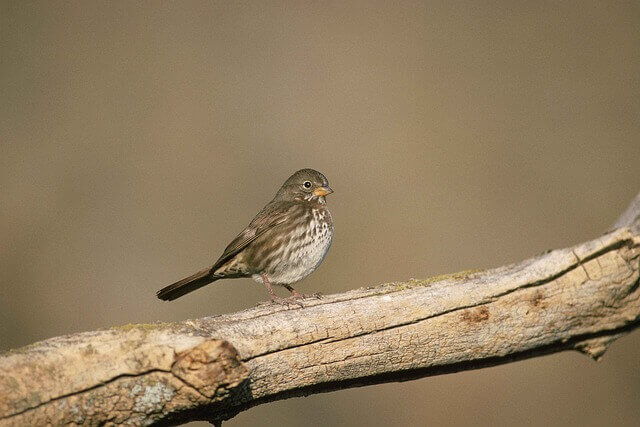
The Fox Sparrow is a medium-sized sparrow with a rusty-red back and grayish-brown breast. Its head is gray with a white eyebrow and black streaks on its face. The Fox Sparrow is about six inches long with a wingspan of about 10 inches. The female Fox Sparrow is similar in appearance to the male, but her colors are not as bright. The Fox Sparrow has a wide range, from Alaska and Canada to the United States and Mexico.
It can be found in forests, woodlands, mountains, and grasslands. The Fox Sparrow prefers open areas with plenty of cover for nesting and foraging. The diet of the Fox Sparrow consists mainly of insects and seeds. In the summer months, the sparrow will eat more insects, such as beetles, grasshoppers, crickets, and caterpillars.
- Frequency: 9.67%
- Color: Heavily spotted and streaked underneath
- Habitat: Coniferous forest, dense mountain scrub, scrubby habitat and backyards.
- Range: Most of North America
- Size: 5.9″ – 7.5″ inches long
- Weight: 26 – 44 grams
- Diet: Seeds, insects.
- Family: Passerellidae
- Genus: Passerella
- Maps: Range Map – Sightings Map
- Sounds: Calls and Songs
Steller’s Jay
The Steller’s Jay (Cyanocitta stelleri) is a medium-sized bird found in the forests of western North America. Its range extends from Alaska and British Columbia to Mexico and California. The Steller’s jay is a member of the crow family. The Steller’s jay is a black and blue bird with a long tail. It is about the size of a robin.
The Steller’s jay is found in forests, woodlands, and mountain areas. It prefers areas with coniferous trees, but it can also be found in deciduous forests. The Steller’s jay diet consists mostly of insects and small mammals, but it will also eat berries, nuts, and seeds.
- Frequency: 9.33%
- Color: Blue crest on the head, wings, back, and tail, and has a white face and belly
- Habitat: Deciduous and mixed forests, mixed woodlands, backyards, parks
- Range: Southern Canada, Eastern and Central United States, Florida and Texas
- Size: 8 – 12″ inches
- Weight: 70 – 100 grams
- Diet: Nuts, seeds, caterpillars, grasshoppers, and beetles
- Family: Corvidae
- Genus: Cyanocitta
- Maps: Range Map – Sightings Map
- Sounds: Calls and Songs
Related: How to Attract Steller’s Jay to your Yard – Expert Tips!
The backyard birds listed below have a frequency of less than 8%.
- Tree Swallow 8.32%
- Northern Shoveler 8.27%
- Hermit Thrush 8.08%
- Chestnut-backed Chickadee 7.70%
- Lincoln’s Sparrow 7.62%
- Boreal Chickadee 7.58%
- Wilson’s Warbler 7.54%
- Golden-crowned Kinglet 7.29%
- Pacific Wren 7.26%
- Golden-crowned Sparrow 6.47%
- Yellow Warbler 6.44%
- Snow Bunting 6.39%
- Canada Jay 5.37%
- Downy Woodpecker 5.19%
- Rock Pigeon 5.19%
- Swainson’s Thrush 5.01%
Frequently Asked Questions
What are the black and white birds called in Alaska?
There are several black and white birds in Alaska, including the Black-billed Magpie, Downy Woodpecker, and Hairy Woodpecker. All of these birds are common in Alaska and can be found in many different habitats. The Black-billed Magpie is a large bird with a black head and white body. This bird is the most common black and white bird in Alaska and can be found in many different habitats.
What are the big black birds in Alaska?
In Alaska, the most common big black bird is the Common Raven. These birds are not only found in Alaska, but all over North America. Ravens are one of the smartest birds around and are known for their mischievous behavior.
What is the most common bird in Alaska?
According to eBird, the most common bird in Alaska is the Common Raven. Ravens are large, black birds well known for their intelligence and eagerness. They are found in many different habitats, including forests, mountains, and tundra. Ravens are scavengers and will eat just about anything, which makes them one of the most successful bird species in the world.
What is the national bird of Alaska?
In 1960, school children in Alaska chose the willow ptarmigan as the official state bird. The willow ptarmigan is a small bird with mottled brown plumage in summer and a snow-white plumage in winter. It is found in tundra and taiga habitats across Alaska. The willow ptarmigan is well-adapted to the cold climate of its homeland, with feathers that provide insulation against the cold and feet that are covered in scales to prevent frostbite.
What is the black bird in Alaska?
There are four species of blackbird that can be found in Alaska: the Rusty Blackbird, Red-winged Blackbird, Brewer’s Blackbird, and Yellow-headed Blackbird. All four of these species are members of the family Icteridae, which contains all the New World orioles and blackbirds. The Rusty Blackbird is the most common of the four species, and can be found in wooded areas throughout Alaska.
Does Alaska have ravens or crows?
Though both the Common Raven and the American Crow are found in Alaska, it is the Common Raven that is most often seen. These large black birds are not only found in wooded areas, but also in open tundra and even in cities.
Are there blue jays in Alaska?
There are no blue jays in Alaska, but there are Steller’s Jays and Canada Jays. The Steller’s Jay is a member of the crow family and is found in coniferous forests throughout Alaska. The Canada Jay is also a member of the crow family and is found in boreal forests throughout Alaska.
What bird has a yellow feather in Alaska?
In Alaska, there are many different types of birds that have yellow feathers. One of the most common is the Yellow Warbler. These birds are typically found near water sources, such as lakes or rivers. They are also known to eat insects, which makes them a valuable asset to any ecosystem.
Does Alaska have finches?
Yes, Alaska does have finches. There are 11 species of finches that have been found in the state, including the Gray-crowned rosy-finch, hawfinch, purple finch, common rosefinch, Cassin’s finch, house finch, Eurasian bullfinch, oriental greenfinch, Pallas’s Rosefinch, American goldfinch and the Asian Rosy-Finch. The most commonly seen species is the gray-crowned rosy-finch, and are often seen in urban areas near bird feeders.
Are there puffins in Alaska?
Yes, there are two types of puffins that can be found in Alaska. The first is the Tufted Puffin and the second is the Horned Puffin. Both of these birds are part of the auk family and are known for their colorful beaks. The Tufted Puffin is the more common of the two and can be found along the coast of Alaska. They nest on cliffs and eat small fish. The Horn Puffin is less common but can also be found along the coast. They eat mainly krill and sometimes squid.
Does Alaska have cardinals?
No, Alaska does not have cardinals. Cardinals are a type of songbird that is found in North and South America. They are renowned for their brilliant red plumage. The closest thing to a cardinal that can be found in Alaska is the redpoll, which is a type of finch.
Does Alaska have pigeons?
There are three species of pigeons in Alaska: Pigeon Guillemot, Rock Pigeon and the Band-tailed Pigeon. All three species are found in different parts of the state. The Pigeon Guillemot is the most common, and is found along the coast, while the Rock Pigeon is found inland. The Band-tailed Pigeon is found in both habitats. All three species are year-round residents of Alaska.
Does Alaska have pheasants?
There are many different types of pheasants, but only one kind is found in Alaska. The ring-necked pheasant is a rare sight in the state, with a frequency of occurrence of only 0.2781%. Although they are not commonly seen, these birds can be found in some areas of Alaska.
Does Alaska have a lot of birds?
Alaska is home to 567 different species of birds, more than any other state in the US. In fact, over 20% of all bird species in North America can be found in Alaska. The state’s diverse landscape and climate provide habitat for a wide range of birds, from seabirds to shorebirds to songbirds.
What kind of grouse are in Alaska?
There are four different species of grouse in Alaska: the Spruce Grouse, the Sooty Grouse, the Ruffed Grouse, and the Sharp-tailed Grouse. All of them are rare, with the Sharp-tailed Grouse being the most endangered. The Spruce Grouse is the most common of the four, and it is found in forests throughout Alaska.
Are chickadees in Alaska?
There are five species of chickadees in Alaska, the Black-capped Chickadee, Chestnut-backed Chickadee, Boreal Chickadee, Gray-headed Chickadee, Mountain Chickadee. All five species are found in different parts of the state. The Black-capped Chickadee is the most common, and is found in all parts of Alaska. The other four species are found in specific areas of the state.
Are juncos in Alaska?
There are many different types of juncos, however, only one species is found in Alaska. The dark-eyed junco is a small sparrow with a gray body and white belly. It has a pink bill and dark gray wings with white bars. The dark-eyed junco is a common bird in Alaska and can be found in many different habitats including forests, meadows, and tundra.
Are toucans in Alaska?
There are no toucans in Alaska. The state is too cold for these tropical birds. Toucans are found in Central and South America, where the climate is warm and humid. Toucans need a warm, wet environment to thrive. They would not be able to survive in the cold, dry climate of Alaska.
Are there meadowlarks in Alaska?
According to eBird, the Western Meadowlark is a very rare bird in Alaska with a frequency of occurrence of only 0.0201%. This means that out of 10,000 birds observed in Alaska, only two or three are likely to be Meadowlarks. The main reason for their rarity is because they prefer open grassland habitat, which is not common in Alaska. There are occasional sightings of Meadowlarks in the state, but they are not known to breed here.
Do mockingbirds live in Alaska?
The Northern Mockingbird is the only species of mockingbird that lives in Alaska, and according to eBird, they are very rare, with a frequency of occurrence of only 0.0052%.
Are there doves in Alaska?
There are four species of doves in Alaska: Eurasian Collared-Dove, Dovekie, Mourning Dove, and Oriental Turtle-Dove. All four species are very rare, and can be found in different parts of the state. The Eurasian Collared-Dove is the most common, and is found in urban and suburban areas.


